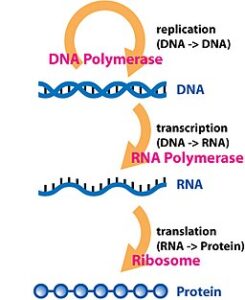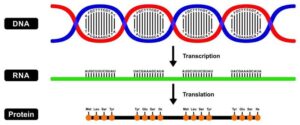Back to: MICROBIOLOGY 500 LEVEL
Welcome to class!
Hello brilliant one! I’m so glad you’re here today. You know, having you in this virtual class is like sitting across the table from a determined, future-changing Nigerian youth ready to make a real difference in the world. Let’s walk this learning journey together—step by step, at your pace, and in a way that speaks to your world. You ready? Let’s begin!
Central Dogma: Dna → RNA → Protein
Have you ever wondered how your body knows exactly how to build cells, tissues, enzymes and even fight off infections—all on its own? It’s not magic—it’s science. And the beautiful system that helps living organisms manage all of this is what we call the Central Dogma of Molecular Biology.

Think of it like a well-organised production line in a Nigerian textile factory. First, you have a design (DNA), which is copied into a pattern sheet (RNA), and then used to sew the actual outfit (Protein). Each step matters and must follow a specific order. That’s exactly how cells manage life.
What is the Central Dogma?
The Central Dogma is the fundamental concept in molecular biology that explains how genetic information flows within a biological system. It follows a clear path: DNA is transcribed into RNA, and RNA is translated into Protein. Just like our traditional ‘chain of command’ in a well-run household or workplace, there’s a structured flow from information to function.
Step 1: DNA Transcription (DNA → RNA)
Imagine DNA as a recipe book stored safely in the manager’s office. When a worker (cell) needs to prepare a dish (protein), they don’t take the whole book. Instead, they make a photocopy of just the recipe needed. That photocopy is RNA—specifically messenger RNA (mRNA).

This process of making RNA from DNA is called transcription. It happens in the nucleus. Special enzymes like RNA polymerase read the DNA and produce a strand of mRNA that carries the genetic message out of the nucleus.
Step 2: RNA Translation (RNA → Protein)
Now that the worker (cell) has the copied recipe (mRNA), it’s taken to the kitchen (ribosome), where the actual cooking happens. This process is called translation.
Here, the ribosome reads the mRNA and, with the help of transfer RNA (tRNA), assembles amino acids into a specific protein. Each group of three bases on the mRNA (called a codon) tells the ribosome which amino acid to add next. This step-by-step process continues until the full protein is built—just like putting together each part of a jollof rice dish: rice, pepper, onions, spices, and meat.
Why is this important?

Everything from the melanin in your skin to the insulin that regulates sugar in your blood depends on this system. Proteins are the actual workers in the body—they do everything from building muscles to digesting food. And none of this would happen without the instructions from DNA and the messenger service of RNA.
Summary
- The Central Dogma describes how genetic information flows: DNA → RNA → Protein.
- Transcription is the process where DNA is used to make RNA.
- Translation is the process where RNA is used to build proteins.
- Proteins are the functional molecules that carry out most life processes.
Evaluation
- What is the central dogma of molecular biology?
- Describe the processes of transcription and translation.
- Why are proteins important in the body?
You’re doing so well, and I’m proud of how far you’ve come! Remember, every time you understand something new, you’re building a stronger, smarter, and more capable version of yourself. Keep showing up with curiosity and confidence—Afrilearn is here to cheer you on and guide you every step of the way. See you in the next lesson!
